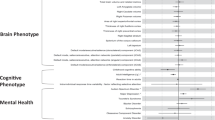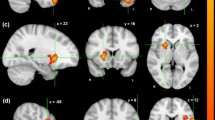Abstract
During the process of developing the DSM-5, a new phenotype of ADHD was proposed—the ADHD restrictive inattentive presentation (ADHD-RI), describing subjects with high endorsement of inattentive symptoms and a low level of hyperactivity. However, this phenotype was not included in the DSM-5 because of the lack of robust neurobiological data. We aimed to assess the specific neurobiological underpinnings of individuals presenting ADHD-RI. We compared a sample of 301 subjects (101 ADHD-Combined; 50 ADHD-RI; 50 ADHD predominantly inattentive type and 100 typically developing subjects) aged 8–15 years, using a complete neuropsychological battery, molecular genetic data (DRD4 and DAT1 most studied polymorphisms) and functional MRI during a Go-No/Go task. Subjects with ADHD-RI had a significantly different neuropsychological profile compared with the other groups, including lower psychomotor speeds, longer reaction times and the worst overall performance in the global neurocognitive index. The proportion of subjects with the presence of DRD4–7 repeat allele was significantly higher in ADHD-RI. The fMRI data suggested that more attention-related posterior brain regions (especially temporo-occipital areas) are activated in ADHD-RI during both Go and No-Go cues compared to TD controls and ADHD predominantly inattentive type. ADHD-RI may represent a different phenotype than other types of ADHD. In addition, our results suggest that reducing the phenotypic heterogeneity may aid in the search for the neurobiological underpinnings of ADHD.

Similar content being viewed by others
References
Willcutt EG, Nigg JT, Pennington BF, Solanto MV, Rohde LA, Tannock R, Loo SK, Carlson CL, McBurnett K, Lahey BB (2012) Validity of DSM-IV attention deficit/hyperactivity disorder symptom dimensions and subtypes. J Abnorm Psychol 121(4):991–1010
Scassellati C, Bonvicini C, Faraone SV, Gennarelli M (2012) Biomarkers and attention-deficit/hyperactivity disorder: a systematic review and meta-analyses. J Am Acad Child Adolesc Psychiatry 51(10):1003–1019
APA (2013) Diagnostic and statistical manual of mental disorders, DSM-V, 5th edn. American Psychiatric Association, Washington DC
Geurts HM, Verté S, Oosterlaan J, Roeyers H, Sergeant JA (2005) ADHD subtypes: do they differ in their executive functioning profile? Arch Clin Neuropsychol 20(4):457–477
Goth-Owens T, Martinez-Torteya C, Martel M, Nigg JT (2010) Processing speed weakness in children and adolescents with non-hyperactive but inattentive ADHD (ADD). Child Neuropsychol 16(6):577–591
Genro JP, Kieling C, Rohde LA, Hutz MH (2010) Attention-deficit/hyperactivity disorder and the dopaminergic hypotheses. Expert Rev Neurother 10(4):587–601
Gizer IR, Ficks C, Waldman ID (2009) Candidate gene studies of ADHD: a meta-analytic review. Human Genet 126(1):51–90
Ciliax BJ, Drash GW, Staley JK, Haber S, Mobley CJ, Miller GW, Mufson EJ, Mash DC, Levey AI (1999) Immunocytochemical localization of the dopamine transporter in human brain. J Comp Neurol 409(1):38–56
Noain D, Avale ME, Wedemeyer C, Calvo D, Peper M, Rubinstein M (2006) Identification of brain neurons expressing the dopamine D4 receptor gene using BAC transgenic mice. Eur J Neurosci 24(9):2429–2438
Shaw P, Gornick M, Lerch J, Addington A, Seal J, Greenstein D, Sharp W, Evans A, Giedd JN, Castellanos FX, Rapoport JL (2007) Polymorphisms of the dopamine D4 receptor, clinical outcome, and cortical structure in attention-deficit/hyperactivity disorder. Arch Gen Psychiatry 64(8):921–931
Fair DA, Nigg JT, Iyer S, Bathula D, Mills KL, Dosenbach NU, Schlaggar BL, Mennes M, Gutman D, Bangaru S, Buitelaar JK, Dickstein DP, Di Martino A, Kennedy DN, Kelly C, Luna B, Schweitzer JB, Velanova K, Wang YF, Stewart M, Castellanos FX, Milham MP (2013) Distinct neural signatures detected for ADHD subtypes after controlling for micro-movements in resting state functional connectivity MRI data. Front Syst Neurosci 6:80. doi:10.3389/fnsys.2012.00080 (eCollection2012)
Volk HE, Todorov AA, Hay DA, Todd RD (2009) Simple identification of complex ADHD subtypes using current symptom counts. J Am Acad Child Adolesc Psychiatry 48(4):441–450
Nigg JT, Tannock R, Rohde LA (2010) What is to be the fate of ADHD subtypes? An introduction to the special section on research on the ADHD subtypes and implications for the DSM–V. J Clin Child Adolesc Psychol 39(6):723–725
Achenbach TM (1991) Integrative guide for the 1991 CBCL/4-18, YSR, and TRF profiles. Department of Psychiatry, University of Vermont, Burlington
Ercan ES, Amado S, Somer O, Çıkoğlu S (2001) Dikkat eksikliği hiperaktivite bozukluğu ve yıkıcı davranım bozuklukları için bir test bataryası geliştirme çabası. Çocuk ve Gençlik Ruh Sağlığı Dergisi 8(3):132–144
Gökler B, Ünal F, Pehlivantürk B, Kültür EÇ, Akdemir D, Taner Y (2004) Reliability and validity of schedule for affective disorders and schizophrenia for school age children-present and lifetime version-turkish version (K-SADS-PL-T). Turk J Child Adolesc Ment Health 11(3):109–116
Leckman JF, Sholomskas D, Thompson D, Belanger A, Weissman MM (1982) Best estimate of lifetime psychiatric diagnosis: a methodological study. Arch Gen Psychiatry 39(8):879–883
Gualtieri CT, Johnson LG (2008) Age-related cognitive decline in patients with mood disorders. Prog Neuro Psychopharmacol Biol Psychiatry 32(4):962–967
Durston S, Thomas KM, Worden MS, Yang Y, Casey BJ (2002) The effect of preceding context on inhibition: an event-related fMRI study. NeuroImage 16(2):449–453
Smith SM, Zhang Y, Jenkinson M, Chen J, Mathhews PM, Federico A, De Stefano N (2002) Accurate, robust, and automated longitudinal and cross-sectional brain change analysis. NeuroImage 17(1):479–489
Woolrich MW, Behrens TE, Beckmann CF, Jenkinson M, Smith SM (2004) Multilevel linear modelling for FMRI group analysis using Bayesian inference. NeuroImage 21(4):1732–1747
Forman SD, Cohen JD, Fitzgerald M, Eddy WF, Mintun MA, Noll DC (1995) Improved assessment of significant activation in functional magnetic resonance imaging (fMRI): use of a cluster-size threshold. Magn Reson Med 33(5):636–647
Derefinko KJ, Adams ZW, Milich R, Fillmore MT, Lorch EP, Lynam DR (2008) Response style differences in the inattentive and combined subtypes of attention-deficit/hyperactivity disorder. J Abnorm Child Psychol 36(5):745–758
Rowe DC, Stever C, Giedinghagen LN, Gard JM, Cleveland HH, Terris ST, Mohr JH, Sherman S, Abramowitz A, Waldman ID (1998) Dopamine DRD4 receptor polymorphism and attention deficit hyperactivity disorder. Mol Psychiatry 3(5):419–426
McCracken JT, Smalley SL, McGough JJ, Crawford L, Del’Homme M, Cantor RM (2000) Evidence for linkage of a tandem duplication polymorphism upstream of the dopamine D4 receptor gene (DRD4) with attention deficit hyperactivity disorder (ADHD). Mol Psychiatry 5(5):531–536
Schmidt LA, Fox NA, Perez-Edgar K, Hu S, Hamer DH (2001) Association of DRD4 with attention problems in normal childhood development. Psychiatr Genet 11(1):25–29
Cheuk DKL, Li SYH, Wong V (2006) Exon 3 polymorphisms of dopamine D4 receptor (DRD4) gene and attention deficit hyperactivity disorder in Chinese children. Am J Med Genet Part B Neuropsychiatr Genet 141(8):907–911
Ahrendts J, Rüsch N, Wilke M, Philipsen A, Eickhoff SB, Glauche V, Perlov E, Ebert D, Hennig J, Tebartz van Elst Z (2011) Visual cortex abnormalities in adults with ADHD: a structural MRI study. World J Biol Psychiatry 12(4):260–270
Proal E, Reiss PT, Klein RG, Manuzza S, Gotimer K, Ramos-Olazagasti MA, Belsky ER, Hutchison JA, Lashua-Shriftman E, Castellanos FX (2011) Brain gray matter deficits at 33-year follow-up in adults with attention-deficit/hyperactivity disorder established in childhood. Arch Gen Psychiatr 68(11):1122–1134
Castellanos FX, Proal E (2012) Large-scale brain systems in ADHD: beyond the prefrontal–striatal model. Trend Cognit Sci 16(1):17–26
Cortese S, Kelly C, Chabernaud C, Proal E, Di Martino A, Milham MP, Castellanos FX (2012) Toward systems neuroscience of ADHD: a meta-analysis of 55 fMRI studies. Am J Psychiatry 169(11):1038–1055
Hart H, Radua J, Mataix-Cols D, Rubia K (2012) Meta-analysis of fMRI studies of timing in attention-deficit hyperactivity disorder (ADHD). Neurosci Biobehav Rev 36(10):2248–2256
Dillo W, Göke A, Prox-Vagedes V, Szycik GR, Roy M, Donnerstag F, Emrich HM, Ohlmeier MD (2010) Neuronal correlates of ADHD in adults with evidence for compensation strategies—a functional MRI study with a Go/No-Go paradigm. Ger Med Sci GMS (e-journal 8:Doc09)
Schneider-Garces NJ, Gordon BA, Brumback-Peltz CR, Shin E, Lee Y, Sutton BP, Fabiani M (2010) Span, CRUNCH, and beyond: working memory capacity and the aging brain. J Cognit Neurosci 22(4):655–669
Kessler RC, Green JG, Adler LA, Barkley LA, Chatterji S, Faraone SV, Finkelman M, Greenhill LL, Gruber MJ, Jewell M, Russo LJ, Sampson NA, Van Brunt DL (2010) Structure and diagnosis of adult attention-deficit/hyperactivity disorder: analysis of expanded symptom criteria from the Adult ADHD Clinical Diagnostic Scale. Arch Gen Psychiatry 67(11):1168–1178
Guney E, Iseri E, Ergun SG, Percin EF, Ergun MA, Yalcin O (2013) The correlation of attention deficit hyperactivity disorder with DRD4 gene polymorphism in Turkey. Int J Hum Genet 13(3):145–152
Woo CW, Krishnan A, Wager TD (2014) Cluster-extent based thresholding in fMRI analyses: pitfalls and recommendations. NeuroImage 91:412–419
Acknowledgments
This work was partially supported by research grants from the following: Ege University Scientific Research Project Commission, Izmir, Turkey, the National Council for Scientific and Technological Development (CNPq, Brazil), and Hospital de Clinicas de Porto Alegre (HCPA), Porto Alegre, Brazil. The authors thank Dr Cahide Aydın for contribution in case enrollment process.
Conflict of interest
Dr Ercan is a member of the advisory boards for Eli Lilly Turkey and Janssen Turkey. Dr. Luis Augusto Rohde was on the speakers’ bureau and/or acted as consultant for Eli-Lilly, Janssen-Cilag, Novartis and Shire in the last three years. The ADHD and Juvenile Bipolar Disorder Outpatient Programs chaired by him received unrestricted educational and research support from the following pharmaceutical companies in the last three years: Eli-Lilly, Janssen-Cilag, Novartis, and Shire. He also receives research support from Brazilian government institutions (CNPq, FAPERGS, HCPA and CAPES), authorship royalties from Oxford Press and ArtMed and received travel awards for taking part of 2014 APA meeting from Shire. All other authors have declared that they have no competing or potential conflicts of interest in relation to this work.
Author information
Authors and Affiliations
Corresponding author
Electronic supplementary material
Below is the link to the electronic supplementary material.
Rights and permissions
About this article
Cite this article
Ercan, E.S., Suren, S., Bacanlı, A. et al. Decreasing ADHD phenotypic heterogeneity: searching for neurobiological underpinnings of the restrictive inattentive phenotype. Eur Child Adolesc Psychiatry 25, 273–282 (2016). https://doi.org/10.1007/s00787-015-0731-3
Received:
Accepted:
Published:
Issue Date:
DOI: https://doi.org/10.1007/s00787-015-0731-3




